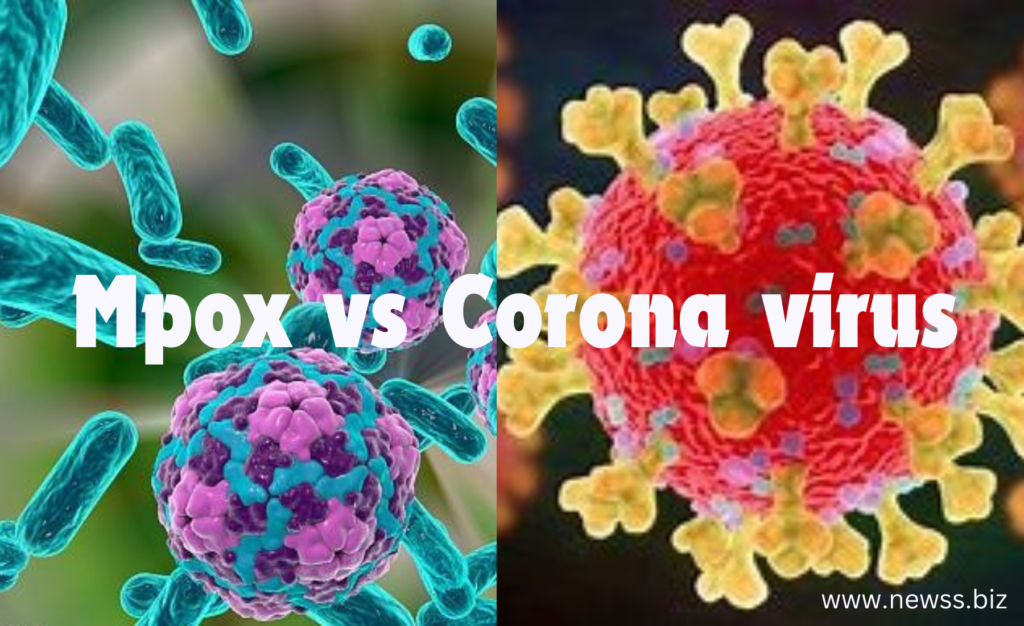Introduction
The Mpox virus and the coronavirus (SARS-CoV-2, responsible for COVID-19) are two viral pathogens that have significantly impacted global public health. While each has its origins, transmission patterns, and impacts, they have also drawn comparisons due to their pandemic potential and the global responses they have triggered. In this blog post, we’ll delve into a detailed comparison of the Mpox virus and coronavirus, discussing their similarities, transmission methods, and which is more harmful.
Origins and Virology
Mpox Virus:
- Family and Genus: The Mpox virus belongs to the Poxviridae family and the Orthopoxvirus genus, which also includes the variola virus responsible for smallpox. It was first identified in 1958 in monkeys and later in humans in 1970.
- Genetic Structure: Mpox is a double-stranded DNA virus. It has a relatively stable genome, meaning it mutates at a slower rate compared to RNA viruses, making it more predictable in terms of outbreaks and transmission.
Coronavirus:
- Family and Genus: SARS-CoV-2 belongs to the Coronaviridae family and the Betacoronavirus genus. It was first identified in Wuhan, China, in late 2019, leading to the COVID-19 pandemic.
- Genetic Structure: SARS-CoV-2 is a single-stranded RNA virus, which is prone to frequent mutations. These mutations have resulted in the emergence of various variants, influencing transmission rates, severity, and vaccine efficacy.
Transmission Mechanisms
Mpox Virus:
- Transmission: Mpox primarily spreads through close contact with an infected individual or animal. Human-to-human transmission can occur via respiratory droplets, direct contact with bodily fluids or lesions, or indirectly through contaminated objects such as bedding or clothing. Zoonotic transmission from animals to humans is also common, particularly in regions where the virus is endemic.
- Transmission Rate: Mpox is not highly contagious compared to respiratory viruses. Its transmission often requires prolonged close contact, making it less likely to cause widespread outbreaks.
Coronavirus:
- Transmission: SARS-CoV-2 is primarily spread through respiratory droplets when an infected person coughs, sneezes, or talks. It can also be transmitted via aerosols (smaller particles that linger in the air) and, less commonly, through contact with contaminated surfaces.
- Transmission Rate: Coronavirus is highly contagious, especially in its airborne form. It can spread rapidly in crowded, indoor settings, leading to large outbreaks. The virus’s ability to mutate has also influenced its transmission dynamics, with some variants being more transmissible than the original strain.
Similarities Between Mpox Virus and Coronavirus
- Zoonotic Origins: Both viruses are zoonotic, meaning they originated in animals before jumping to humans. Mpox likely originated from rodents, while SARS-CoV-2 is believed to have originated in bats, possibly with an intermediate host.
- Global Impact: Both viruses have caused significant global concern, leading to widespread public health measures. Mpox has had localized outbreaks, while SARS-CoV-2 caused a global pandemic.
- Symptoms: While the specific symptoms differ, both viruses can cause fever, fatigue, and body aches. Mpox typically leads to a characteristic rash, while COVID-19 is known for respiratory symptoms, although both can present with a wide range of clinical manifestations.
- Preventative Measures: Measures such as quarantine, isolation, vaccination, and public health awareness campaigns have been crucial in controlling the spread of both viruses.
Which Virus is More Harmful?
Mpox Virus:
- Mortality Rate: Mpox has a lower mortality rate, typically ranging from 1% to 10%, depending on the strain and the region. Most cases are mild, but severe cases can occur, particularly in children or immunocompromised individuals.
- Severity: Mpox generally causes less severe illness compared to COVID-19, with symptoms often resolving within a few weeks.
Coronavirus:
- Mortality Rate: The mortality rate of COVID-19 varies widely depending on factors such as the patient’s age, underlying health conditions, and healthcare availability. Early estimates ranged from 2% to 3%, though this has fluctuated with different variants and improved treatments.
- Severity: COVID-19 can cause severe respiratory illness, multi-organ failure, and long-term health complications (often referred to as “long COVID”). Its ability to overwhelm healthcare systems and cause widespread mortality makes it more harmful on a global scale.
In summary, while Mpox is serious and requires monitoring, COVID-19 has proven to be more harmful overall due to its high transmission rate, ability to cause severe illness, and impact on global healthcare systems.
FAQ: Mpox Virus vs. Coronavirus
Q1: Can Mpox cause a pandemic like COVID-19? Mpox is less likely to cause a pandemic due to its lower transmission rate and the requirement for close contact for spread. However, localized outbreaks can occur, particularly in regions where the virus is endemic or where public health measures are not adequately implemented.
Q2: Which virus is more contagious? SARS-CoV-2 is far more contagious than the Mpox virus, primarily due to its ability to spread through airborne transmission, making it easier to spread in large populations quickly.
Q3: Are there vaccines for both viruses? Yes, vaccines are available for both. Mpox can be prevented with vaccines originally developed for smallpox, while multiple vaccines have been developed specifically for COVID-19.
Q4: Can someone get infected with both viruses simultaneously? While theoretically possible, co-infection with both Mpox and SARS-CoV-2 is extremely rare. However, contracting one virus does not provide immunity to the other.
Q5: What should I do if I suspect I have either virus? If you suspect you have Mpox or COVID-19, seek medical attention immediately. Isolate yourself to prevent spreading the virus to others and follow the guidance of your healthcare provider regarding testing and treatment.
Conclusion
Both the Mpox virus and the coronavirus have had significant impacts on global health, though their transmission patterns and levels of harm differ. Understanding these differences is crucial for effectively managing and preventing future outbreaks. While Mpox is generally less harmful and less contagious, COVID-19 has proven to be a more severe global threat, highlighting the importance of continued vigilance and public health preparedness.



